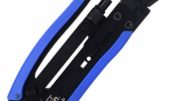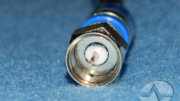It seems like RG6 cable is everywhere. It’s used on satellite TV, over-the-air antennas, cell boosters… it’s the one cable that can pretty much do it all. You’ll even find it in some home audio setups. But it wasn’t always so. There was a time when satellite TV didn’t even exist, when TV antennas used flat lead 300 ohm wire, and when cell boosters used 50 ohm cables. Why did everyone standardize on this one cable?
It’s not like there was a massive conspiracy, and it’s not like manufacturers got together to declare RG6 cable the winner in the home video sweepstakes. It just sort of… happened.
Before there was RG6
TV antennas used to use that flat cable because its characteristics were most similar to the antennas that it connected to. Antennas today are still most similar to 300 ohm wire, which is why each one includes a small circuit to convert it to RG6’s 75 ohms. Coaxial cable is used for antennas now because of its greater ability to shield the signal from outside interference. Old school antenna types will be quick to point out that in many ways that 300-ohm cable was superior. I’m not going to disagree. It’s cheaper to make and carries antenna signals further. But I’ll stop short of saying it was some sort of conspiracy to get you to spend more money. That’s just not true.
Originally TV antennas used RG59 cable which is less expensive and has “enough” shielding for your average antenna install, but RG6 became the norm as its use for other types of communication grew.
RG6 and cell phone signal boosters
Cell boosters once used 50 ohm cable because a lot of the original outdoor antennas were designed first for industrial use, where 50 ohm cable is more common. 50 ohm cable generally has superior performance over longer runs but that isn’t much of a consideration for home cell boosters where runs are generally shorter than 50 feet. For the most part, cell boosters for home use moved over to RG6 cable a decade ago due to consumer demand; average folks didn’t want to buy the more expensive 50 ohm cable. I still recommend 50-ohm boosters with LMR400 cable for larger cell phone signal booster installs. It’s just harder to work with that cable, and it’s generally even more expensive than RG6.
RG6 and satellite TV
As for satellite, it’s always required either RG6 or RG11 cables. RG11 cables are very hard to work with because they’re so thick, and they have some problems in shorter runs. RG6 became the standard because it has enough shielding to protect extremely weak satellite transmissions and it’s also flexible enough to work with in tight spaces. Satellite is really the only type of home theater system that really requires RG6 cable, and because it’s also a good fit for other types of home theater as well, it’s really taken off.
The good part about working with RG6 cable
The good thing about RG6 cables is that they’re everywhere, and they are fairly inexpensive. If you are using them for satellite or amplified antenna use, you’ll need cable with a solid copper center conductor. If you don’t need that capability, you actually can go to the home store and buy fairly passable cable. Or, simply get the best quality cable in custom lengths from your friends at Solid Signal! Not sure which cable you need? Call us at 888-233-7563 during East Coast business hours.





